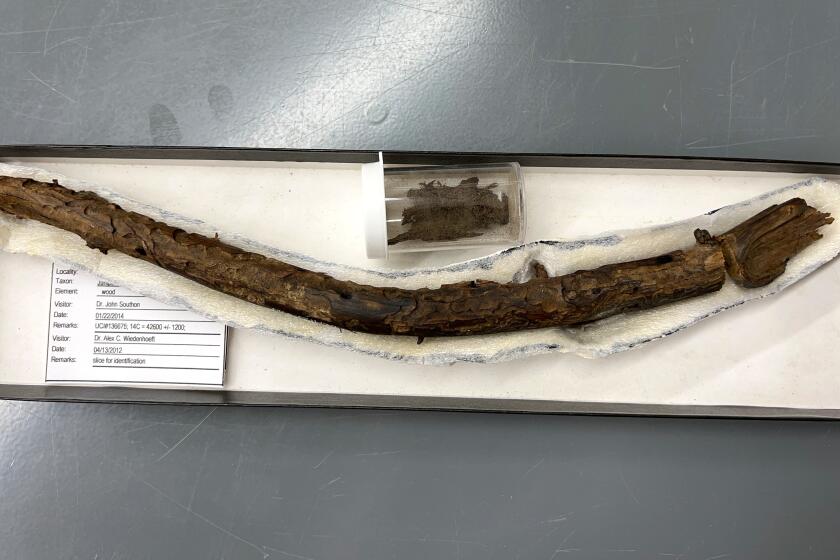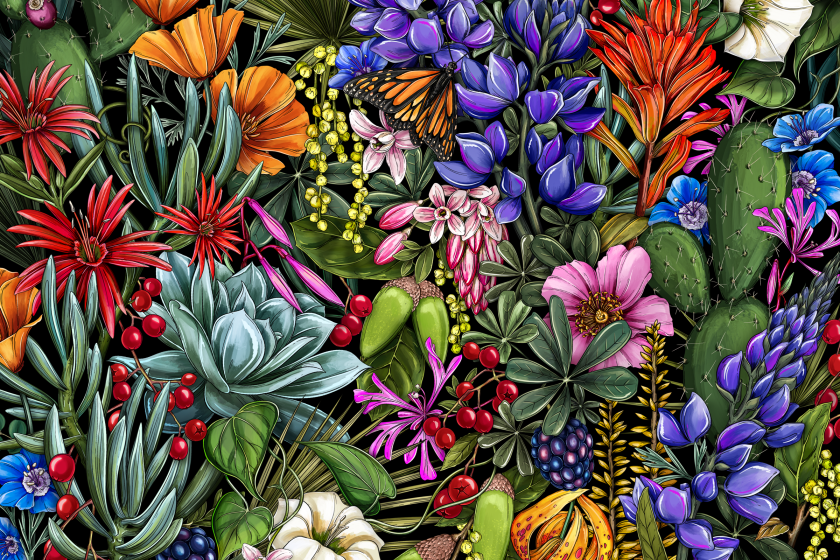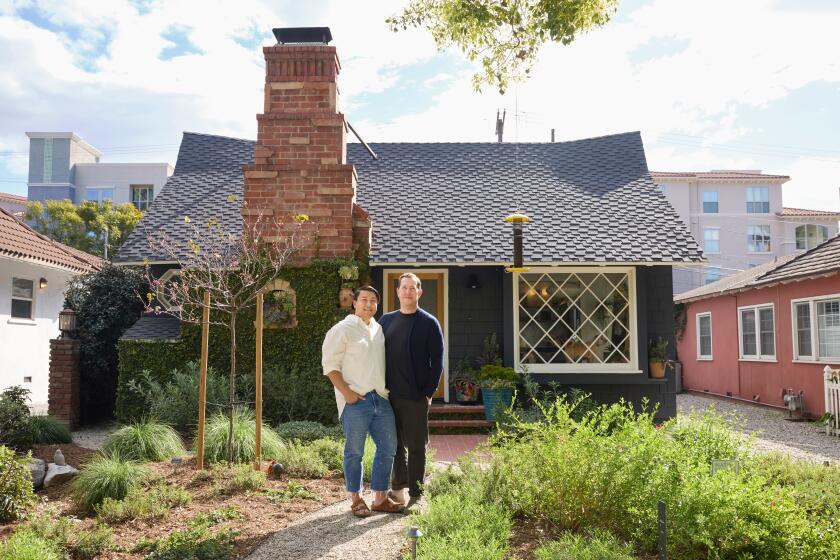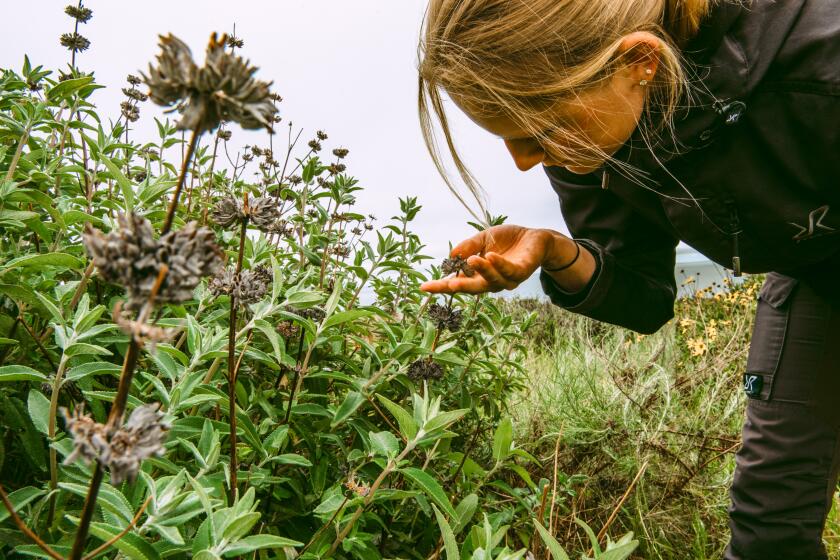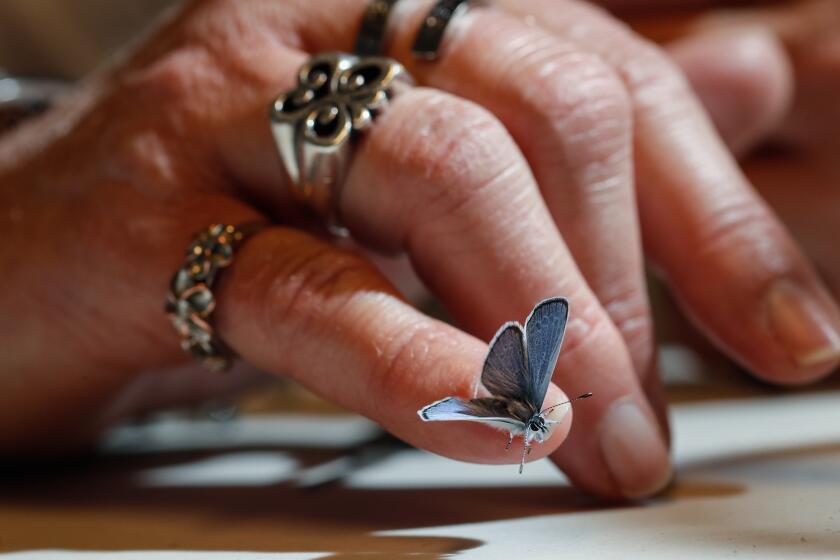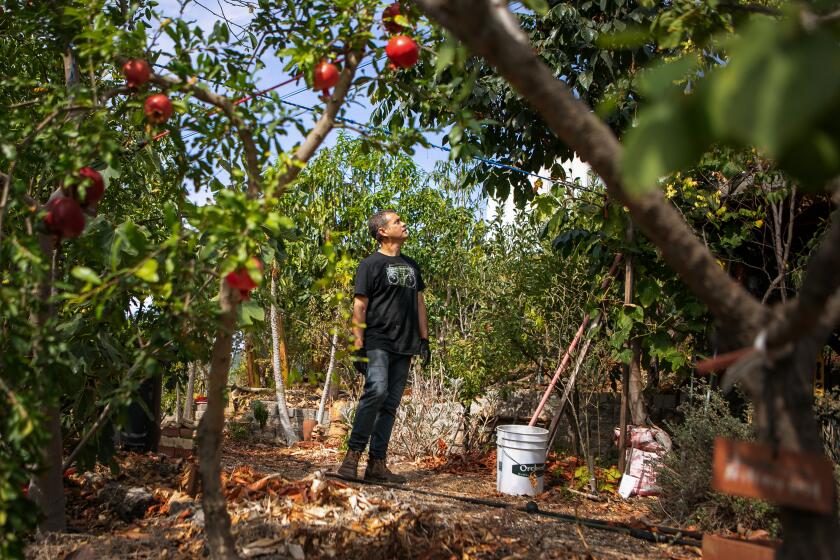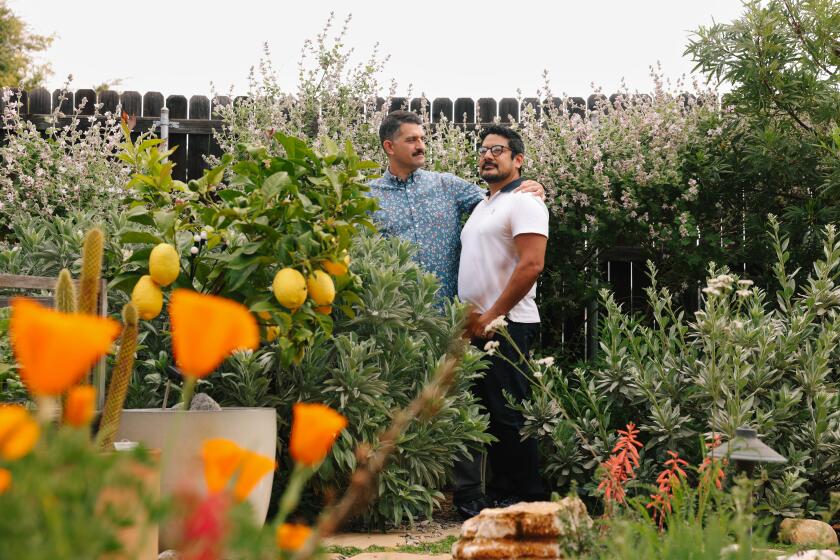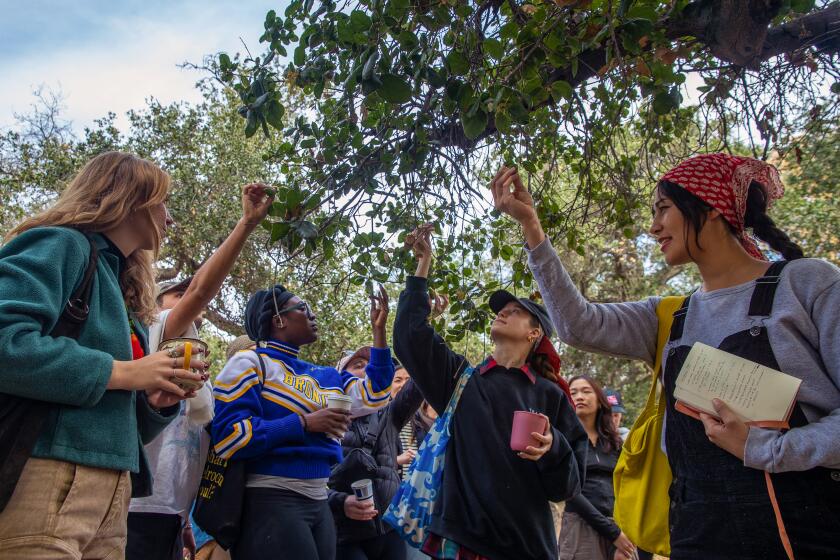Want a landscape that will outlast climate change? Plant these Ice Age survivors
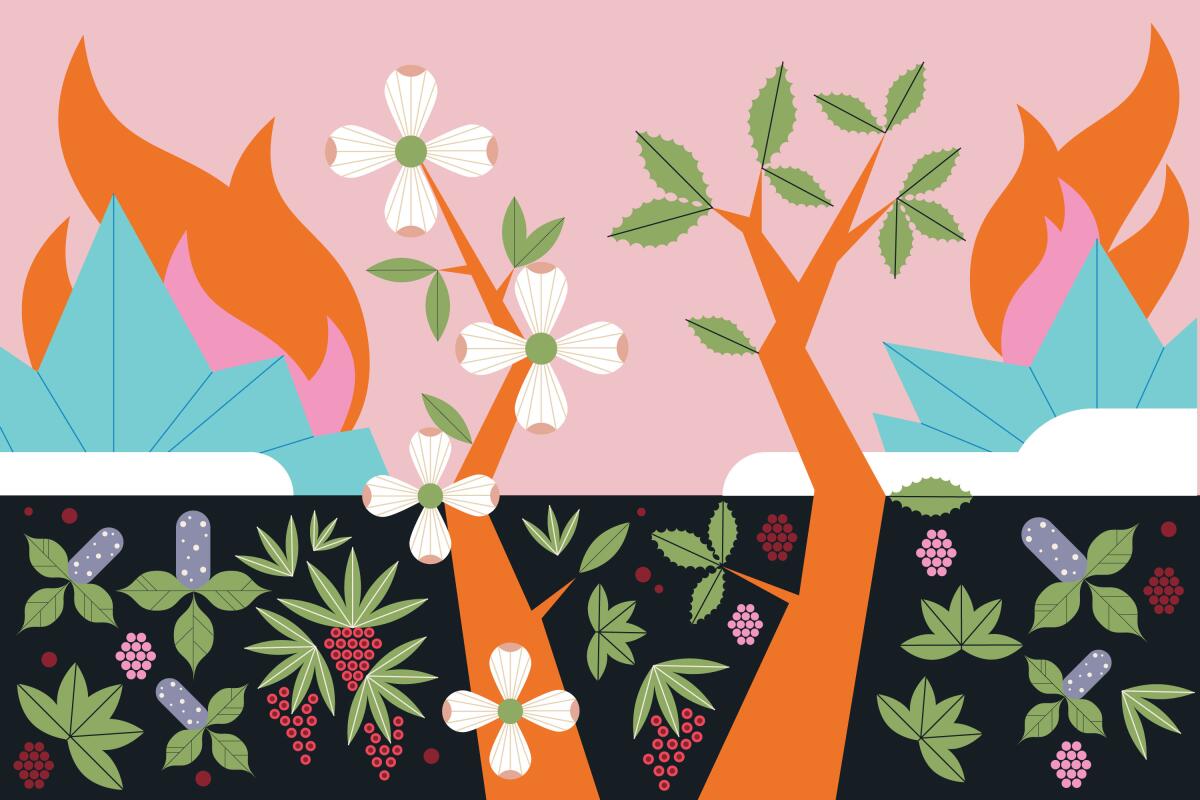
- Share via
Welcome to July! I know it’s hot, but wasn’t it just last month we were grumbling about the gloom?
Researchers say our bodies deal with high heat better after a period of acclimation, so try doing something lightly strenuous outside every day, like a 15-minute walk, and stay well hydrated, so you can take advantage of the many plant-related activities listed below.
But for now, let’s talk climate change — some 13,000 years ago, near the end of the Pleistocene epoch (known as the Ice Age to lay folk), when most of the Earth’s large mammals went extinct and, at least in Southern California, Homo sapiens set the region ablaze.
Inadvertently, of course, but fossil evidence from the La Brea Tar Pits and Museum, Lake Elsinore and other parts of Southern California indicate that about 13,000 years ago this region had an unprecedented number of wildfires over a roughly 300-year span. Researchers believe those fires were created by a perfect storm of climate changes — increasing temperatures, long drought, a fast-shrinking number of grazing animals (who once ate all that flammable flora) and an increase in humans, according to a paper published in Science last year.
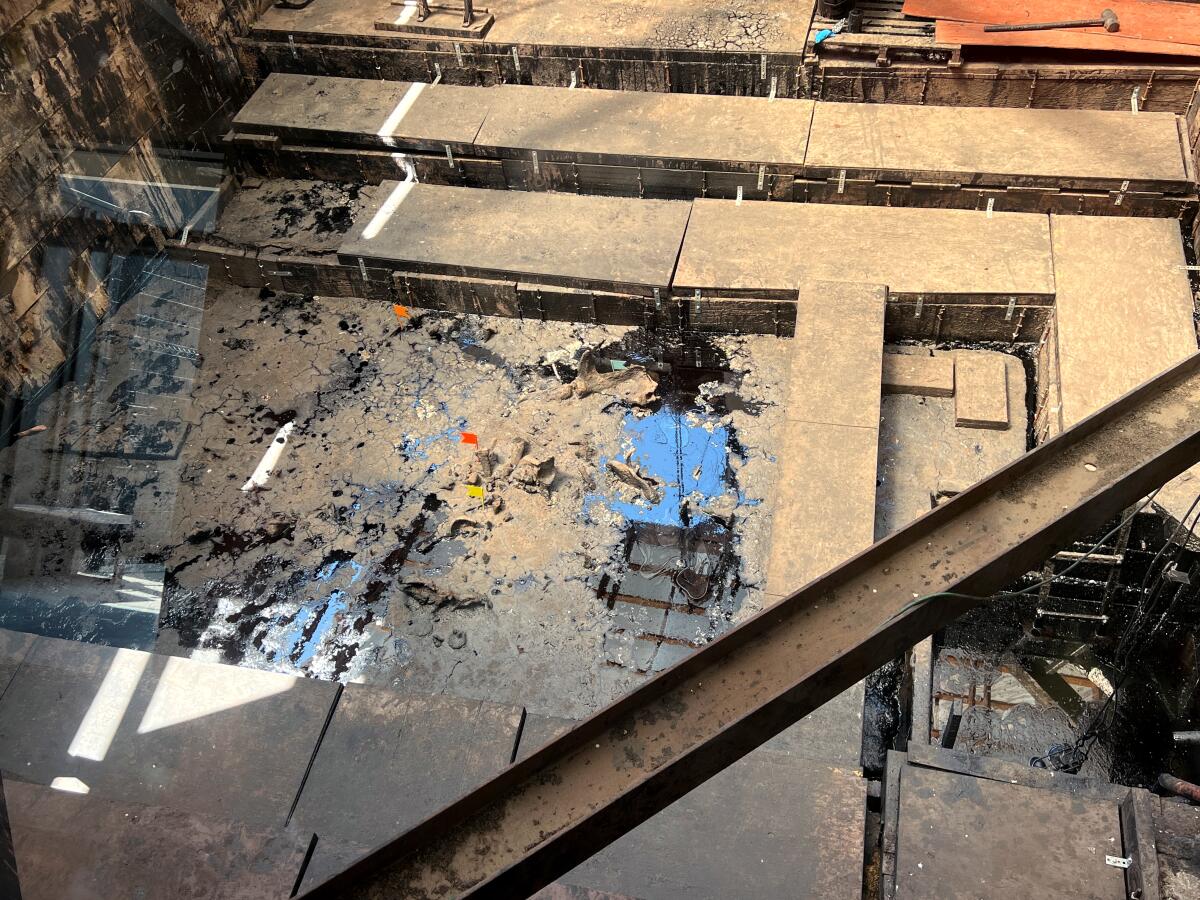
Sound familiar? Well, researchers at the Tar Pits agree. Paleobotanist Jessie George and her colleagues think we can learn a lot about managing today’s climate change by studying the plants that survived the last one.
Which Southern California native plants survived climate change and mass extinctions 13,000 years ago and still live today? La Brea Tar Pits researchers compiled a list.
They’re compiling a list of the native plants trapped in the Tar Pits’ liquid asphalt 13,000 years ago that are still around today, from the surprising — American dogwood (Cornus sericea) — to the stalwarts (ceanothus, toyon, coast live oaks and California sycamore) to the endearing (California poppy) and the obvious (poison oak and California blackberry, apparently tough and annoying enough to join other pesky urban survivors like cockroaches and coyotes).
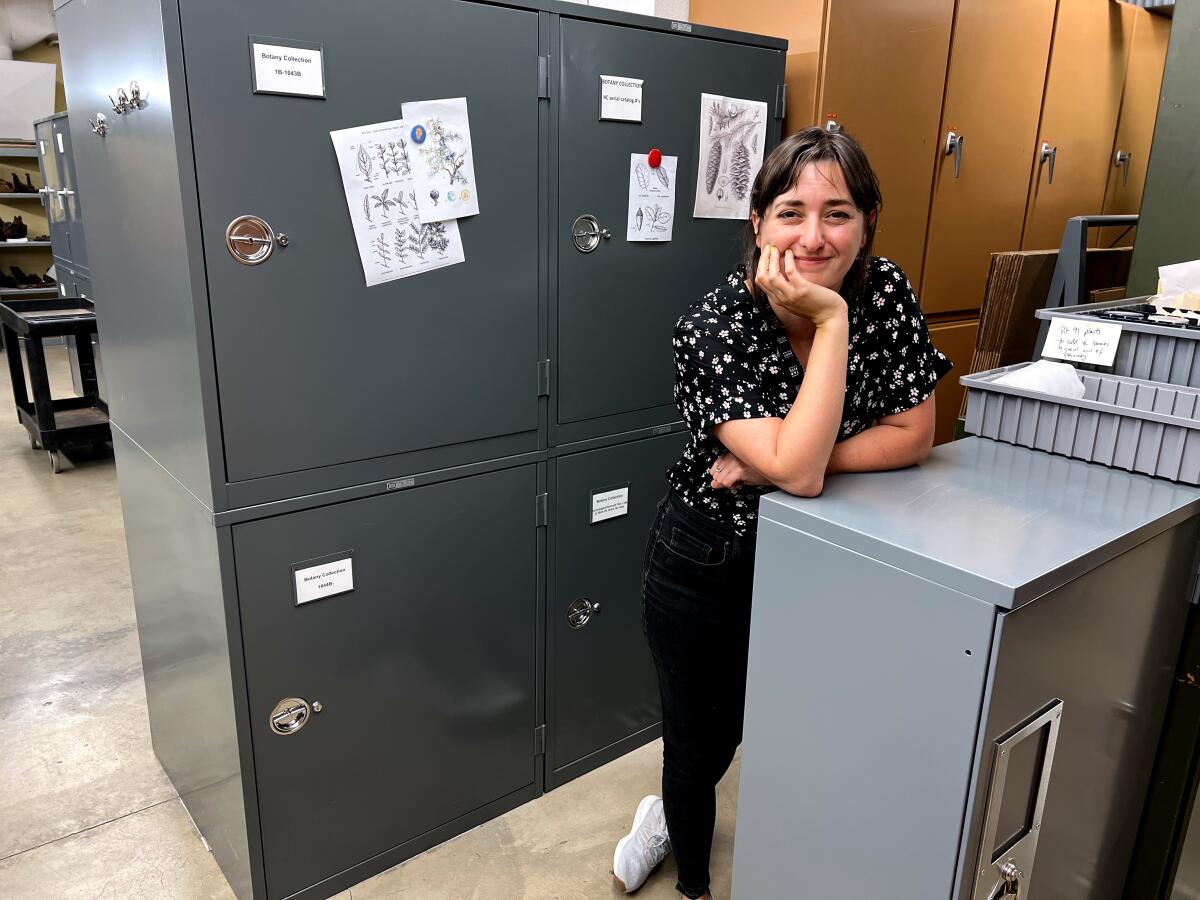
One of their goals is to update the Tar Pit’s Pleistocene Garden of California native plants, created by docent Richard Simun in 2004, to one that more accurately reflects the region’s Ice Age flora still around today.
Researchers have been hauling fossils out of the La Brea Tar Pits’ asphalt-soaked sediment for decades, mostly from “megafauna,” i.e., large mammals that went extinct. (Interesting note: Fossils from the Tar Pits are easily identifiable because they’ve acquired that mahogany hue known as “La Brea Brown” from millenna of soaking in asphalt.)
But every so often, the excavators find a cone or seed or semi-preserved leaf and text the botanists to come take a look, George said. Early researchers weren’t so interested in the plant pieces they found and she doesn’t like to think of the things that were just tossed away as they hunted for the sexier remains of sabertooth cats, dire wolves, American lions and their herbivore prey — bison, giant ground sloths, Western horses and camels.
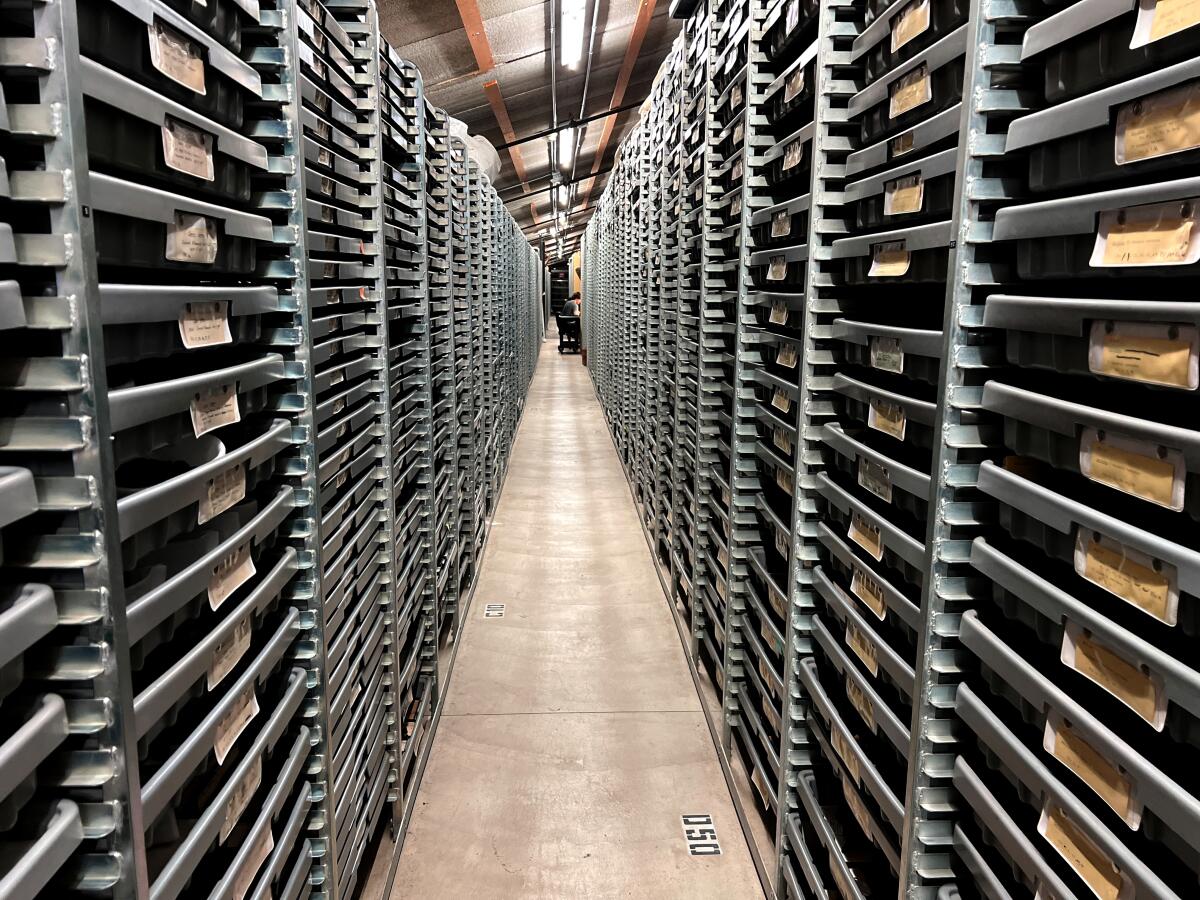
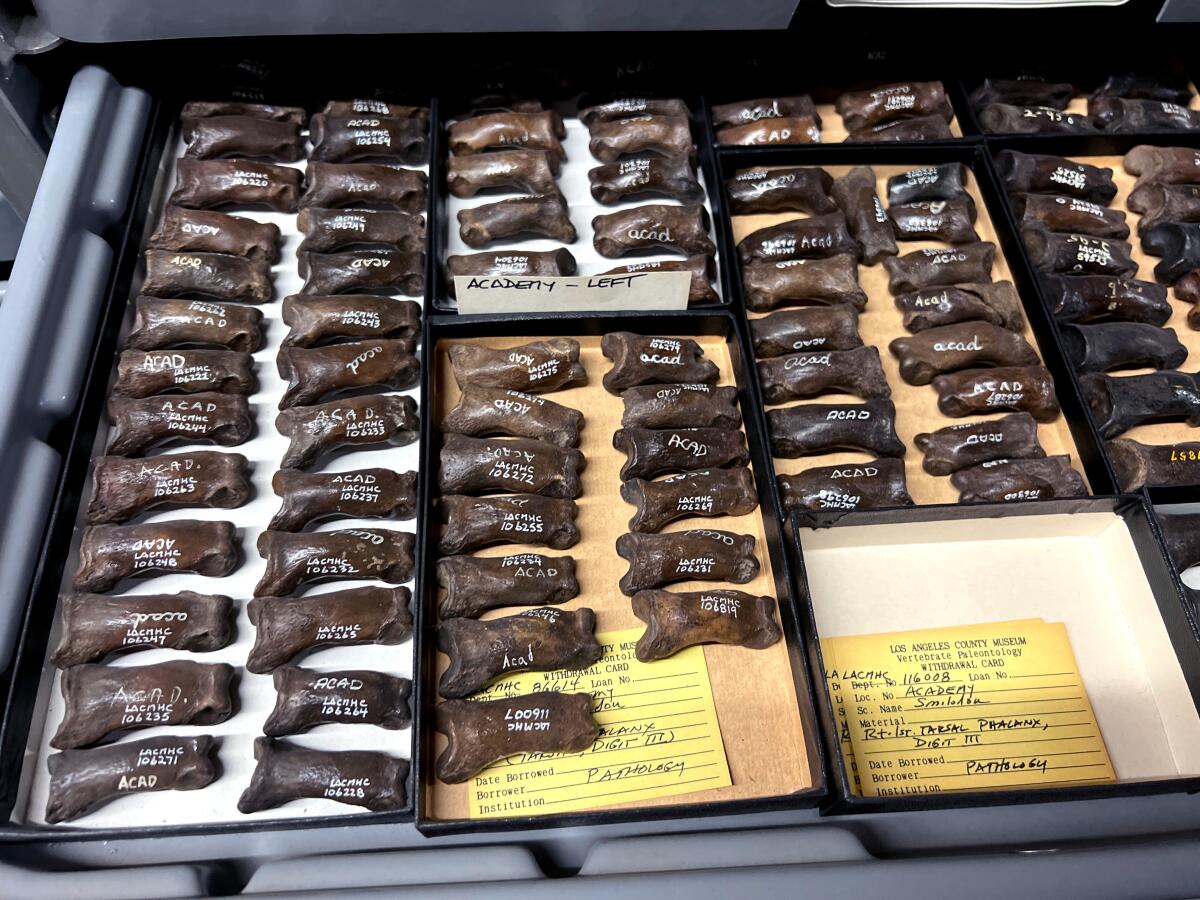
That early bias is clear in the museum’s collections, which feature long corridors stacked floor to ceiling with drawers full of camel vertebrae, for instance, or sabertooth knuckles, versus a small single cabinet filled with the mostly tiny plant remnants saved since excavation began at the Tar Pits in the early 1900s.
But as tiny and fragile as they are, those plant remnants tell an important story, George said. Some 50,000 years ago Southern California was largely a cool, wet woodlands, but by the end of the Ice Age around 11,000 years ago, the landscape had shifted to a dryer, more open area of shrubby chaparral frequently consumed by fire, much as it is today.
The megafauna didn’t survive that change, but smaller animals like coyotes, mule deer, raccoons and turkey vultures adapted and managed to hang on, and so did many plants.
Here are the best retail native plant nurseries in Southern California to help you create a habitat for birds and pollinators in your yard or even on a patio.
The list is a work in progress, and there are only 57 identified so far — trees (or tall shrubs) like California sycamore, coast live oak, blue elderberry, Monterey cypress, big berry manzanita and Monterey pine; grasses like barley and sedge; flowers like blue-eyed grass, asters, sunflowers and purple owl’s clover; and even edibles like wild grapes, miner’s lettuce and Southern California black walnuts.
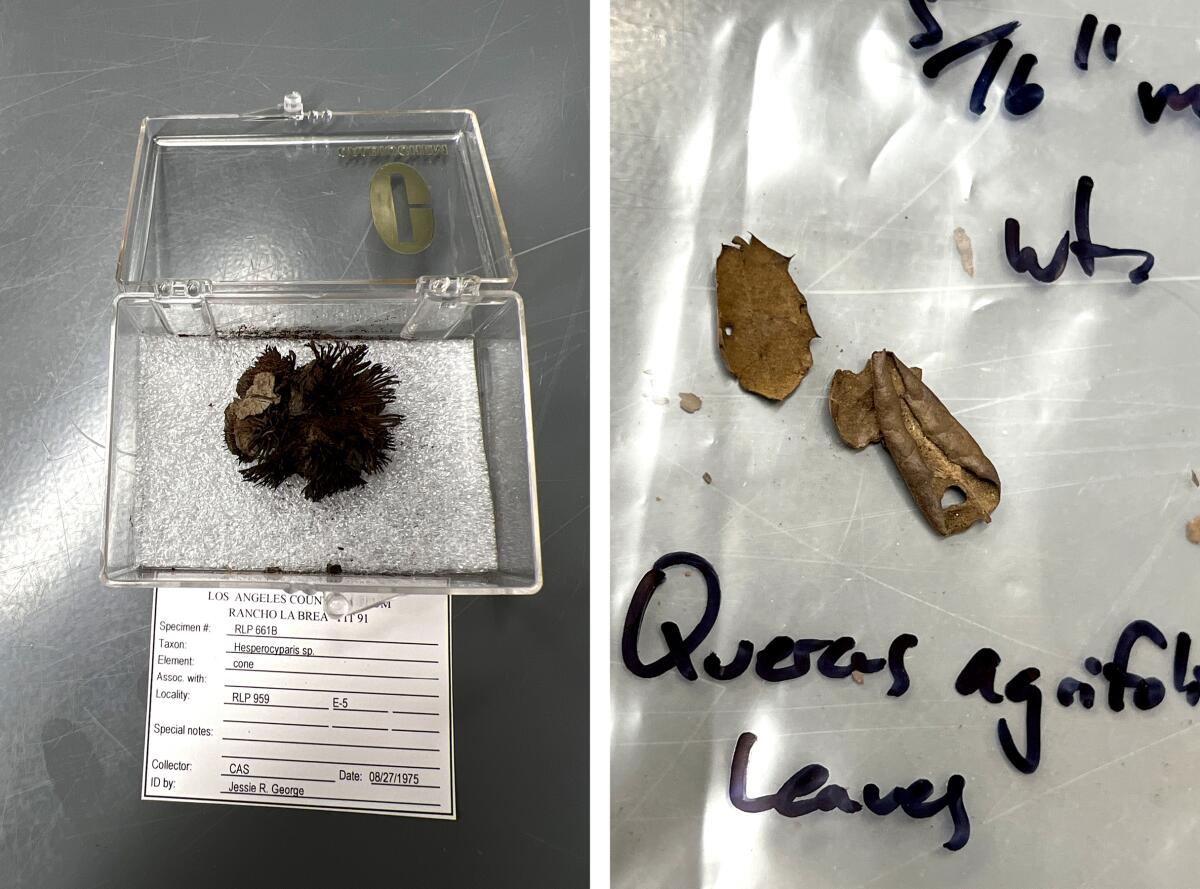
Some of those survivors, like Monterey and Bishop pines, would not fare well in Los Angeles today, George said, but still live in cooler, wetter areas like California’s central coast. But many others, like our golden poppies and ceanothus, still grow in the wild areas around L.A. Knowing the resilient history of these plants, she said, and using them in our landscapes could help us better weather the climate changes happening now.
“La Brea gives you a 50,000-year context into how those plants have done over time. It’s like an experimental laboratory, where you get to see vulnerability or resilience of species through time,” George said. “It’s a powerful tool for urban planning as we go forward.”
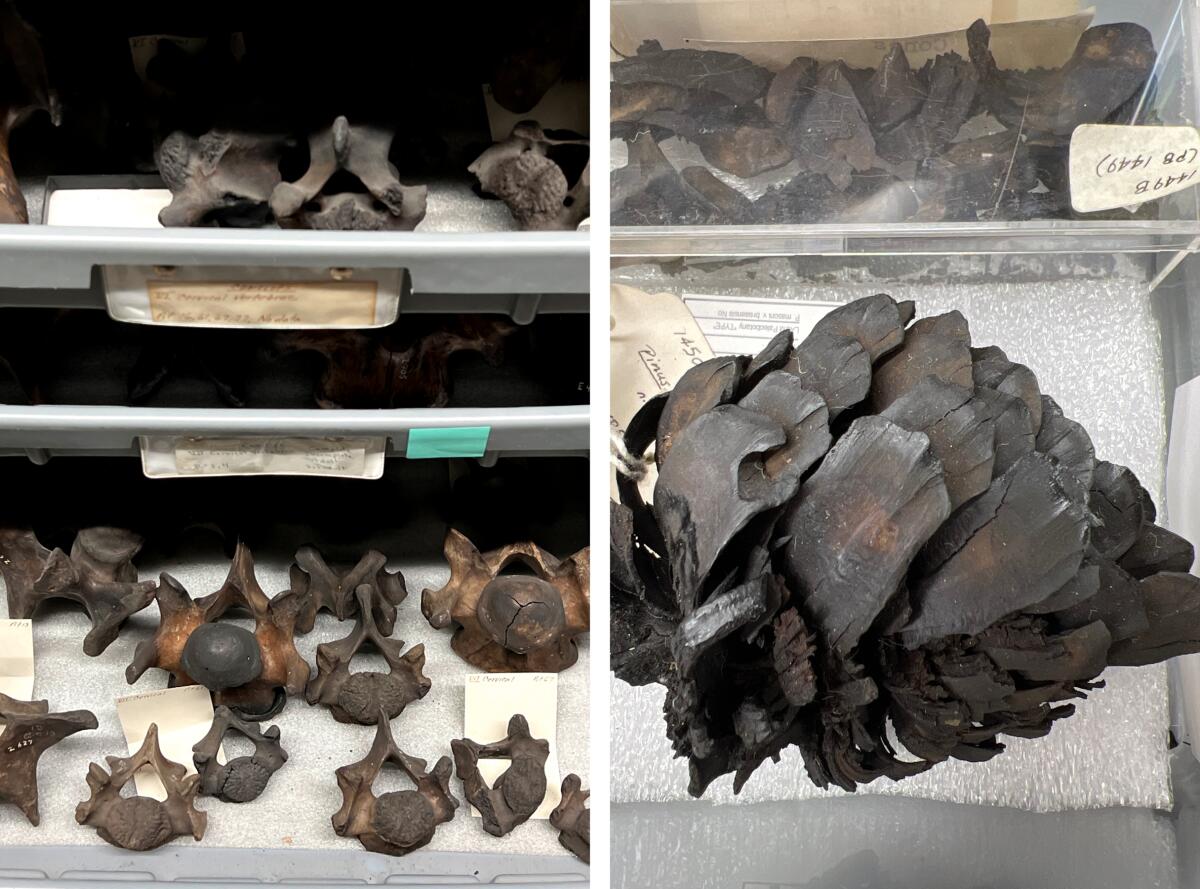
A final sobering thought: Between 14,000 and 13,000 years ago, the average air temperatures around Lake Elsinore increased by 5.6 degrees Celsius, according to the research, and rose another 4.4 degrees Celsius over the next 1,200 years.
To put that into perspective, data from the National Oceanic and Atmospheric Administration (NOAA) show that temperatures in SoCal have increased more than 2 degrees Celsius — roughly 3.6 degrees Fahrenheit — over the last 100 years, a rate of temperature increase significantly higher than the ones that accompanied the region’s mass extinctions and rampant wildfires all those millennia ago.
At that rate, how will oaks and poppies and all us remaining fauna fare in the next few centuries? Will anyone still be around to care?
Heat tips and a plea
Our plants don’t like big heat changes any more than we do, especially when they live in outdoor containers.
I recommend a story I wrote a few years ago listing experts’ 12 tips for helping plants survive a heat wave. The best suggestions are to water your plants deeply before excessive heat events, but don’t drown them by overwatering. Plants shut down when it gets too hot to protect themselves, but that also means they can’t absorb water. If your plant is drooping on a hot day, but the soil is still moist, just wait to water until the morning, after the plant has had time to revive.
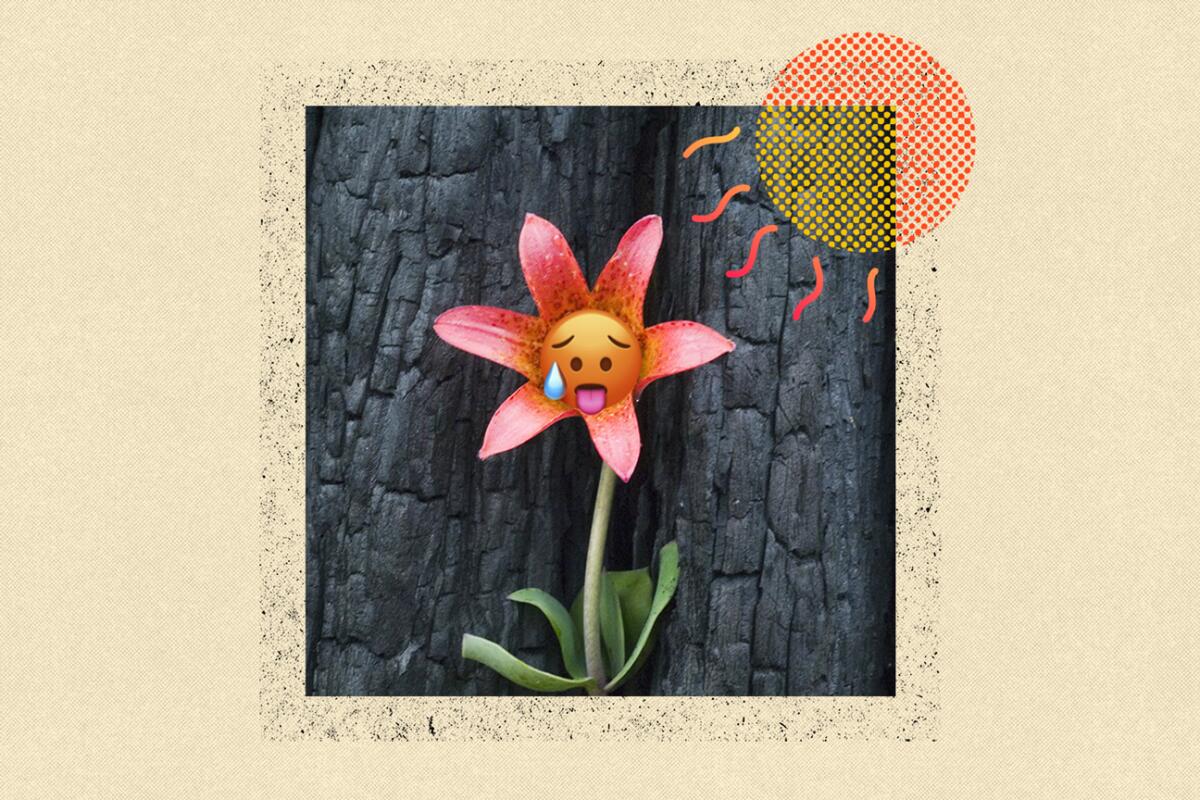
Now for my plea: I know it’s July, but holiday gift guides wait for no reporter and we’re already starting to compile our lists. My assignment is the best gifts for Southern California gardeners and plant parents. Those gifts can be anything plant-related — from tools and seedlings to clothing and experiences — as long as they’re pertinent to SoCal residents and mostly available locally (we don’t just want a list full of Amazon recommendations).
If you have suggestions, send them to [email protected], with the subject line: Plant gift ideas. My gratitude will be boundless.
You’re reading the L.A. Times Plants newsletter
Jeanette Marantos gives you a roundup of upcoming plant-related activities and events in Southern California, along with our latest plant stories.
You may occasionally receive promotional content from the Los Angeles Times.
Upcoming events
July 2
Irrigation Basics for the Native Garden, a Theodore Payne Foundation walk and talk with native plant educator Erik Blank, from 10 to 11:30 a.m. at the foundation’s demonstration gardens in Sun Valley. Tickets are $20 ($15 for members). eventbrite.com
July 3
Reading the Body Language of Trees, a Theodore Payne Foundation walk and talk from 9 a.m. to noon through the Arroyo Seco in Pasadena with consulting arborist Alison Lancaster explaining how and why trees grow the way they do. Tickets are $35 ($25 members). eventbrite.com
July 6
Monarch Nature Trail Volunteer Day, 9 to 11 a.m. in Huntington Beach. Volunteer tasks for all ages include watering, seed collecting, mulching and weeding. Wear tennis shoes, sunscreen and a hat and bring your own water; no restrooms are available on site. Registration is not required. mgorange.ucanr.edu
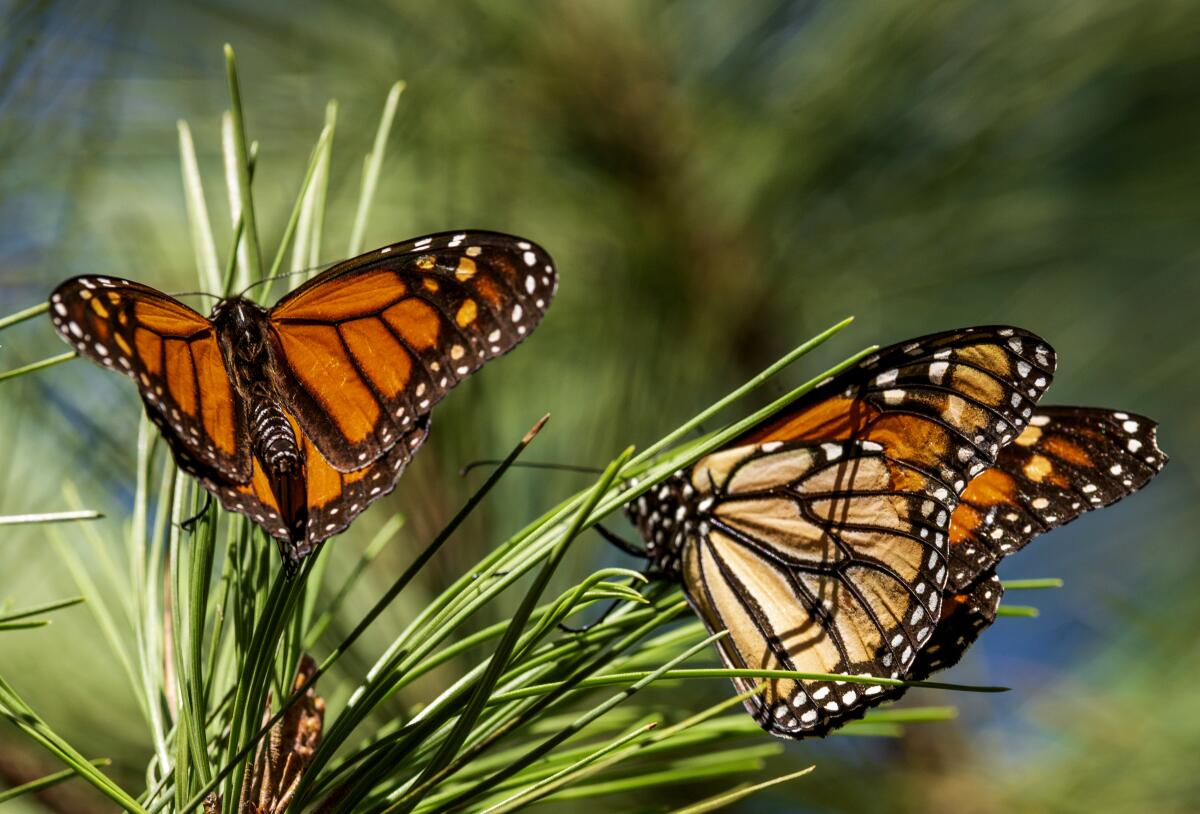
July 9
Storytime in the Garden!, a free, read-aloud summer series of curated children’s books about nature and plants geared toward grade schoolers and their parents that includes a sensory walk for all ages through the Theodore Payne Foundation’s gardens in Sun Valley from 10 to 11 a.m., led by Albert Garnica, the foundation’s education manager. Register online. eventbrite.com
Fire-Resilient Gardens: A Maintenance Walk and Talk led by native plant enthusiast Erik Blank from 10 a.m. to noon at the Theodore Payne Foundation in Sun Valley. Learn how to prune and maintain your garden for wildfire safety. The class is free but registration is required. eventbrite.com
A Studio City couple used FormLA Landscaping to transform their blah yard into a native plant wonderland with meandering paths worthy of their Storybook home.
July 10
Right Plant, Right Place, led by public programs coordinator Kat Ospina from 6 to 8 p.m. at the Theodore Payne Foundation’s gardens in Sun Valley. Learn how to choose the best native plants for your garden space. Tickets are $35 ($25 for members). eventbrite.com
How to Create a Garden Featuring California Native Plants, a free class from 9 to 10 a.m. at the Community Center in Huntington Beach, taught by members of the UC Cooperative Extension Master Gardeners of Orange County. No registration is required. mgorange.ucanr.edu
Getting Started, Lawn Removal and More!, a class about how to remove your lawn and install a native plant landscape in the fall, taught by California Botanic Garden director Lucinda McDade from 6 to 7:30 p.m. at the garden in Claremont. Tickets are $20 ($15 for members). calbg.org
July 10, 13
How to Grow Herbs in Containers, a free class from 3 to 4 p.m. at the Garden Grove Library on July 10 and the El Toro Library in Lake Forest on July 13, taught by members of the UC Cooperative Extension Master Gardeners of Orange County. No registration is required. mgorange.ucanr.edu
July 11
Water Better Not Wetter, a class about conserving water and still having a beautiful landscape, from 1 to 2 p.m. at the Norman P. Murray Community Center in Mission Viejo, taught by members of the UC Cooperative Extension Master Gardeners of Orange County. The class is free but registration is required. missionviejo.perfectmind.com
Sky Corridors: Saving Monarch Butterflies Through Habitat Restoration, a talk by Tim Martinez, land manager and community liaison for the Arroyos & Foothills Conservancy, from 2:30 to 3:30 p.m. at the Brody Botanical Center at the Huntington Library, Art Museum and Botanical Gardens in San Marino. Admission to the talk is free and will be followed by a plant sale, but reservations are required. huntington.org
July 12
Celebrating Seed: Gathering, Processing & Storing Native Seed, 9 a.m. to noon at the Theodore Payne Foundation in Sun Valley, taught by the foundation’s seed program manager, Genevieve Arnold. Tickets are $35 ($25 members). eventbrite.com
One of the easiest ways to learn about California native plants is volunteering to get your hands dirty. Here are some opportunities around Los Angeles, Orange and Santa Barbara counties.
July 13
Santa Rita Hills Lavender Farm’s Lavender Festival includes tours of the farm and its more than 3,000 lavender plants, classes in lavender wreath making, lavender distilling demonstrations, artisan vendors, live music and lavender lemonade, from noon to 5 p.m. at the farm in Lompoc. Admission is free. goldenstateapothecary.com
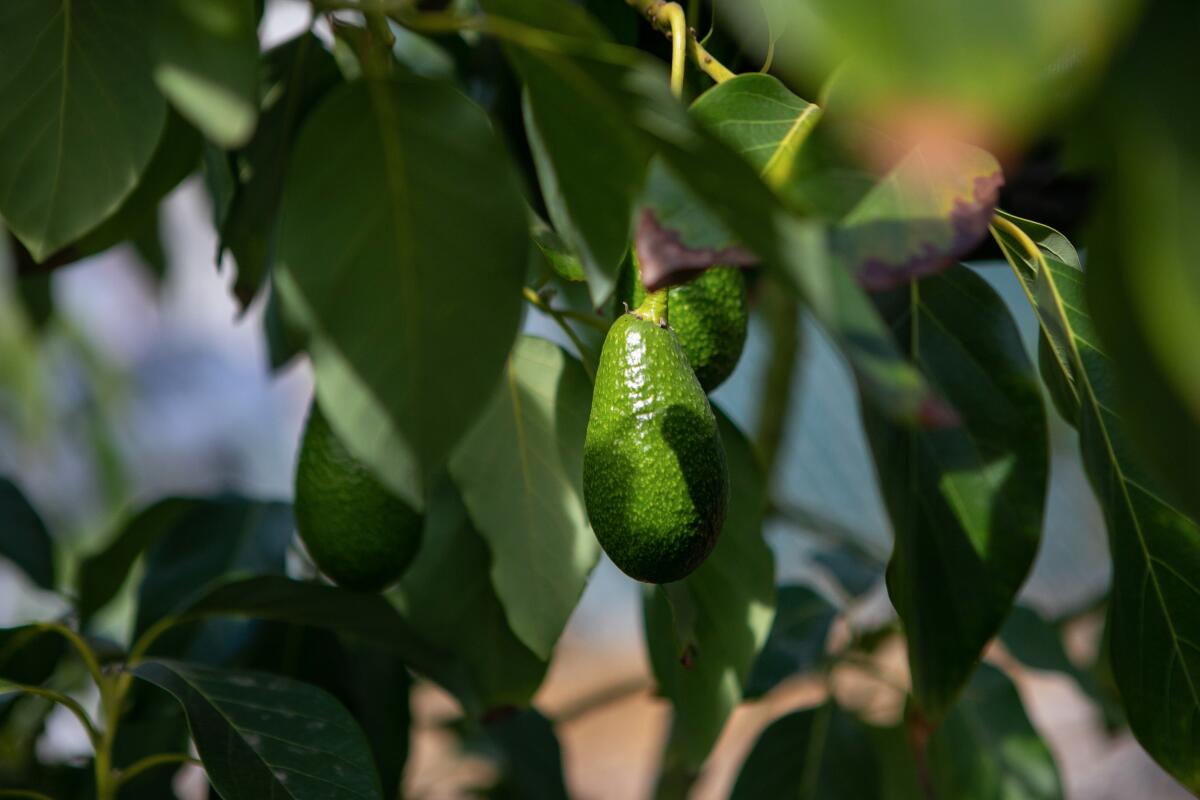
Growing Avocados, a free class from 11 a.m. to noon at the Laguna Beach Library, taught by members of the UC Cooperative Extension Master Gardeners of Orange County. No registration is required. mgorange.ucanr.edu
Summer Garden Sessions in Native Plant Container Gardening, free hourlong classes at 10 a.m. and 2 p.m. at the Theodore Payne Foundation in Sun Valley that include discounts on the nursery’s pottery. Registration encouraged but not required. eventbrite.com
Jana Johnson rebuilt her shattered life by thinking differently and nursing the nearly extinct Palos Verdes blue butterfly back from the brink.
July 13, 20
Annual El Segundo Blue butterfly nature walks hosted by the South Bay Parkland Conservancy, 10:30 a.m. and 12:30 p.m. both days at the Esplanade Bluff in Redondo Beach. The hourlong walks, led by Ann Dalkey, the conservancy’s Esplanade Bluff Restoration Project biologist, and conservancy board member Mary Simun, are free, but advance registration is required. southbayparks.org
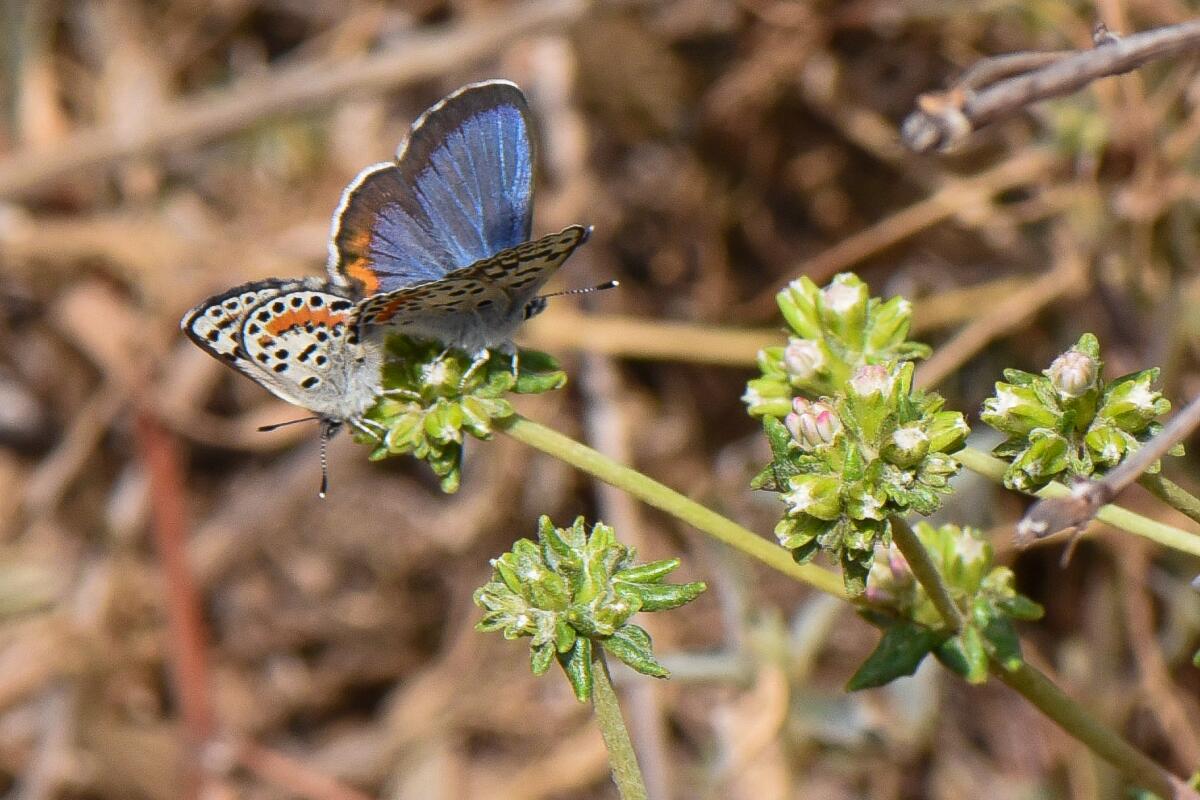
July 13, 27
Drought-Tolerant Plant Sale, including California native plants, succulents and Mediterranean climate plants, 10 a.m. to 2 p.m. at Growing Works Nursery, a typically wholesale nursery in Camarillo offering retail sales with partner Tinyplants on the 2nd and 4th Saturdays of each month. Admission is free. eventbrite.com
Native Plant Sale at Palos Verdes Peninsula Land Conservancy, 10:30 a.m. to noon both days at George F. Canyon Nature Center in Rolling Hills Estates on July 13 and the White Point Nature Education Center in San Pedro on July 27. Admission is free. pvplc.org
July 14
“30+ Years of Growing Succulents Professionally and Learning From Others and the Wild,” a talk by Ernesto Sandoval at the monthly meeting of the South Coast Cactus & Succulent Society at 1 p.m. at South Coast Botanic Garden in Rolling Hills Estates. Admission is free to members and their guests; membership costs $20 a year. southcoastcss.org
Instead of a lawn, Jose Ramirez planted 250 trees, including avocados, limes, apples, mangoes and even coffee beans in his Boyle Heights yard.
How to Create a Backyard Orchard, a free class from 2 to 3 p.m. at the Anaheim Library, taught by members of the UC Cooperative Extension Master Gardeners of Orange County. No registration is required. mgorange.ucanr.edu
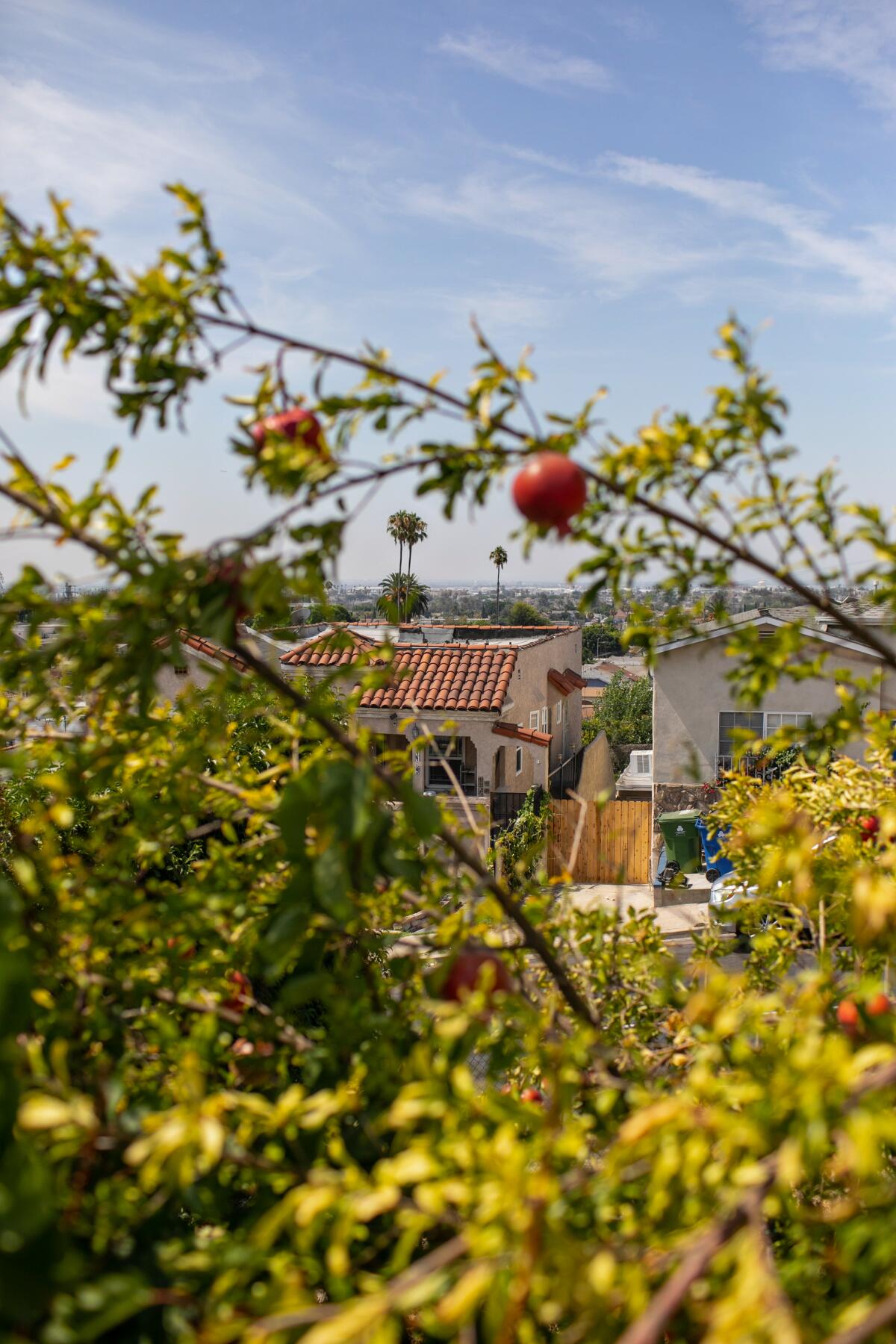
Natural Dying: Summer Colors, a California Botanic Garden workshop taught by artist and naturalist Erin Berkowitz, owner of Berbo Studio in Altadena, from 9 a.m. to 1 p.m. at the garden in Claremont. Learn how to brew colorful dyes from commonly found plants, minerals and even insects and create two silk bandannas. All materials provided. Suitable for ages 12 and older. Tickets are $150 ($135 members). calbg.org
July 17
Fall and Winter Planting in Southern California, a free class on the cultivation and harvesting of 27 vegetables and 70 varieties of flowers, taught by master gardener Yvonne Savio, creator of the Gardening in L.A. website, from 1 to 2 p.m. at the San Marino Community Center. No registration is required. sanmarinoca.gov
Chinese Medicinal Garden Open House at the Huntington Library, Art Museum and Botanical Gardens in San Marino, from 10 a.m. to noon and 1 to 3 p.m. Learn about some of the most important plants used in Chinese medicine for the past 2,000 years at the Huntington’s newest garden. Free with $25 admission to the gardens ($21 seniors 65+ and students with ID, $13 children ages 4 to 11, free to members and children under 4). huntington.org
July 18
Propagating California Native Plants from Seed, taught by Ella Andersson, the Theodore Payne Foundation’s chief botanical technician, 9 a.m. to noon at the foundation in Sun Valley. Participants will take home the seeds they’ve sown and get a tour of the foundation’s seed facilities. All materials provided. Tickets are $85 ($75 for members). eventbrite.com
July 19
Behind the Scenes at the Theodore Payne Foundation, a guided tour of the foundation’s nursery and grounds usually off-limits to the public, 8:30 to 10 a.m at the foundation in Sun Valley. Admission is free but registration is required. eventbrite.com
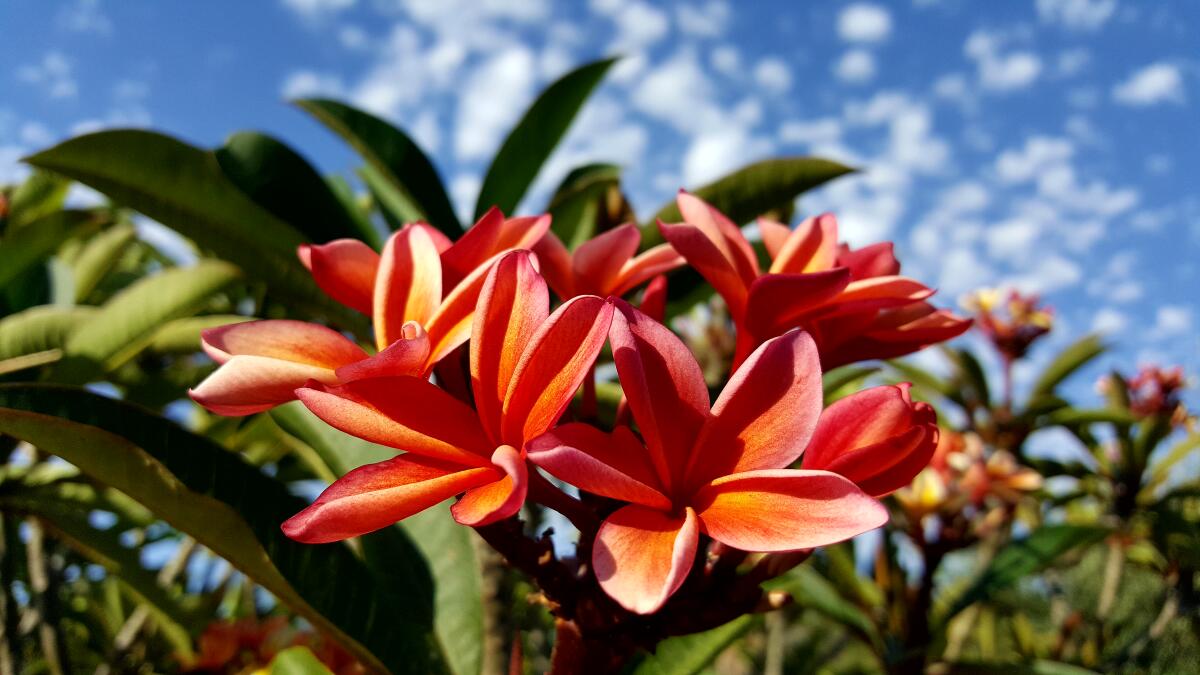
July 19-20
10th Plumeria Festival at the Los Angeles County Arboretum and Botanic Garden, home to the largest public plumeria grove in the continental United States, includes tours, plant vendors and food trucks, 4 to 8 p.m. on July 19, 9 a.m. to 2 p.m. on July 20. Free with $15 admission to the garden ($11 seniors 62+ and students with ID, $5 ages 5-12, children under 5 and members enter free). arboretum.org
July 20
Integrated Pest Management, a class about managing pests in home gardens with little or no pesticides, 10:30 a.m. to 12:30 p.m. at the Great Park in Irvine, taught by members of the UC Cooperative Extension Master Gardeners of Orange County. The class is free but registration is required. secure.yourirvine.org
Gardening Practices & Techniques, a class taught by farmer and educator Francis River on starting and maintaining an organic farm or garden, 10:30 a.m. to 12:30 p.m. at the Avenue 33 Farm in Lincoln Heights. Tickets are $30. usalproject.com
It’s taken a decade, but Raul Rojas and Thomas Zamora have turned a Highland Park yard of hard dirt and junked cars into a lush expanse of native plants, succulents and vegetables.
California Native Butterflies, a presentation by horticulturist Diana Nightingale, 10 a.m. to noon at Descanso Gardens in La Cañada Flintridge. After the talk, Nightingale will lead a search for butterflies in the garden. Tickets are $25 ($20 members). descansogardens.org
July 20-21
Sherman Library & Gardens Annual Plant-O-Rama! Plant Sale, 10:30 a.m. to 4 p.m. at the garden, with a variety of plants sold by members of several plant societies, including the Los Angeles International Fern Society, Newport Harbor Orchid Society, Orange County Begonia Society, Saddleback Valley Bromeliad Society, Southern California Carnivorous Plant Enthusiasts and the Orange County Chapter of the California Native Plant Society. Free with $5 admission to the garden (members and children 3 and under enter free). thesherman.org
July 21
Intro to Beekeeping, a hands-on workshop taught by certified master beekeeper Phoebe Piper, 10 a.m. to 4 p.m. in Malibu. The class includes an in-hive experience and instruction in the biology and care of bees. Bee suits will be provided. Tickets are $100. usalproject.com
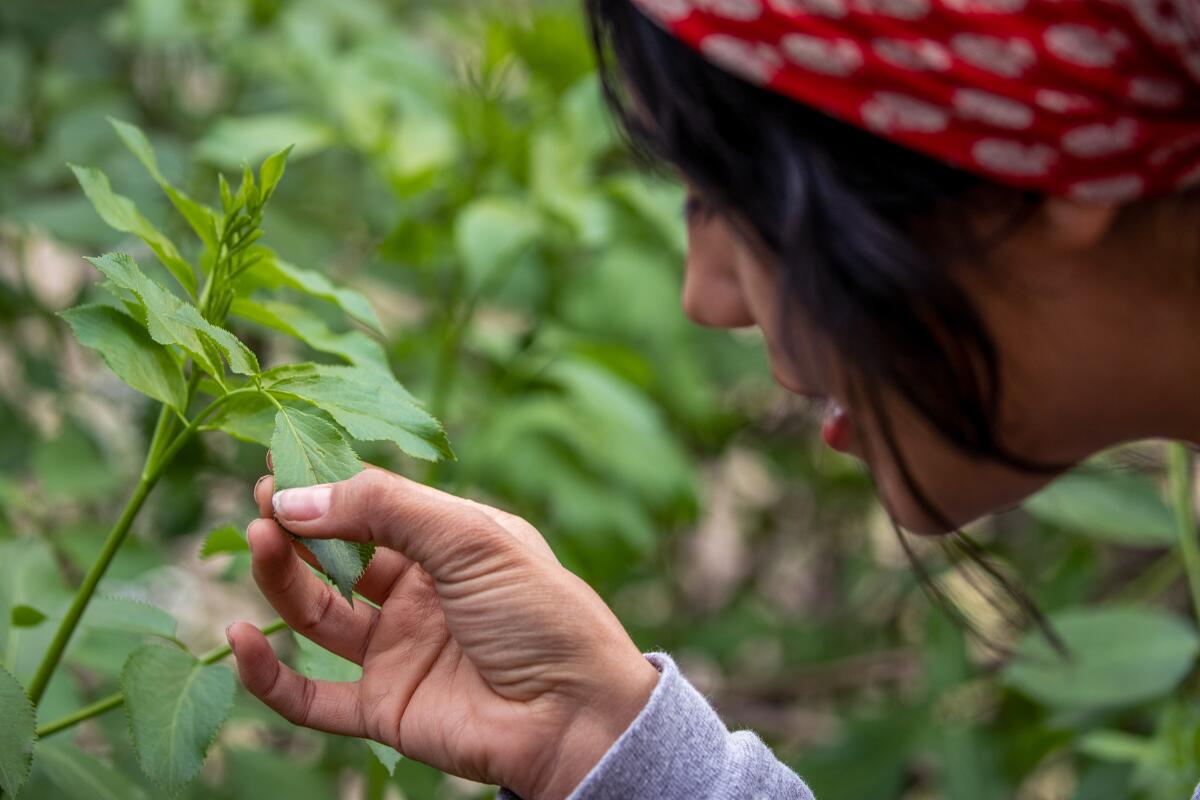
Herb Walk with Andrea Jimenez, founder of Herb Club L.A. Learn to identify and gather native plants for teas and medicinal purposes from 11 a.m. to 1 p.m. along the Walnut Forest Trail in South Pasadena. Tickets are $35. usalproject.com
How to Grow a Cocktail-Inspired Garden, a class taught by South Coast Botanic Garden staff about how to grow and harvest herbal ingredients for infusions and syrups, from 2 to 4 p.m. at the garden in Rolling Hills Estates. Tickets are $50 ($45 members) and include admission to the garden and two craft mocktails. 46664a.blackbaudhosting.com
After feeling unfulfilled as a music talent manager, Michael Washington immersed himself in the outdoors and launched USAL Project, which has become a cool kids nature club.
July 26
Intro to California Native Plant Design with Tim Becker, horticulture director of the Theodore Payne Foundation, 9 a.m. to noon at the foundation in Sun Valley. Tickets are $55 ($50 members). eventbrite.com
July 27
Tomatomania’s 2024 Tomato Tasting Happy Hour from 6 to 9 p.m. at Fig Earth Supply in Mt. Washington. Sample more than 50 tomato varieties and enter a salsa competition, along with beer and wine. Tickets are $45 plus one homegrown tomato. figearthsupply.com
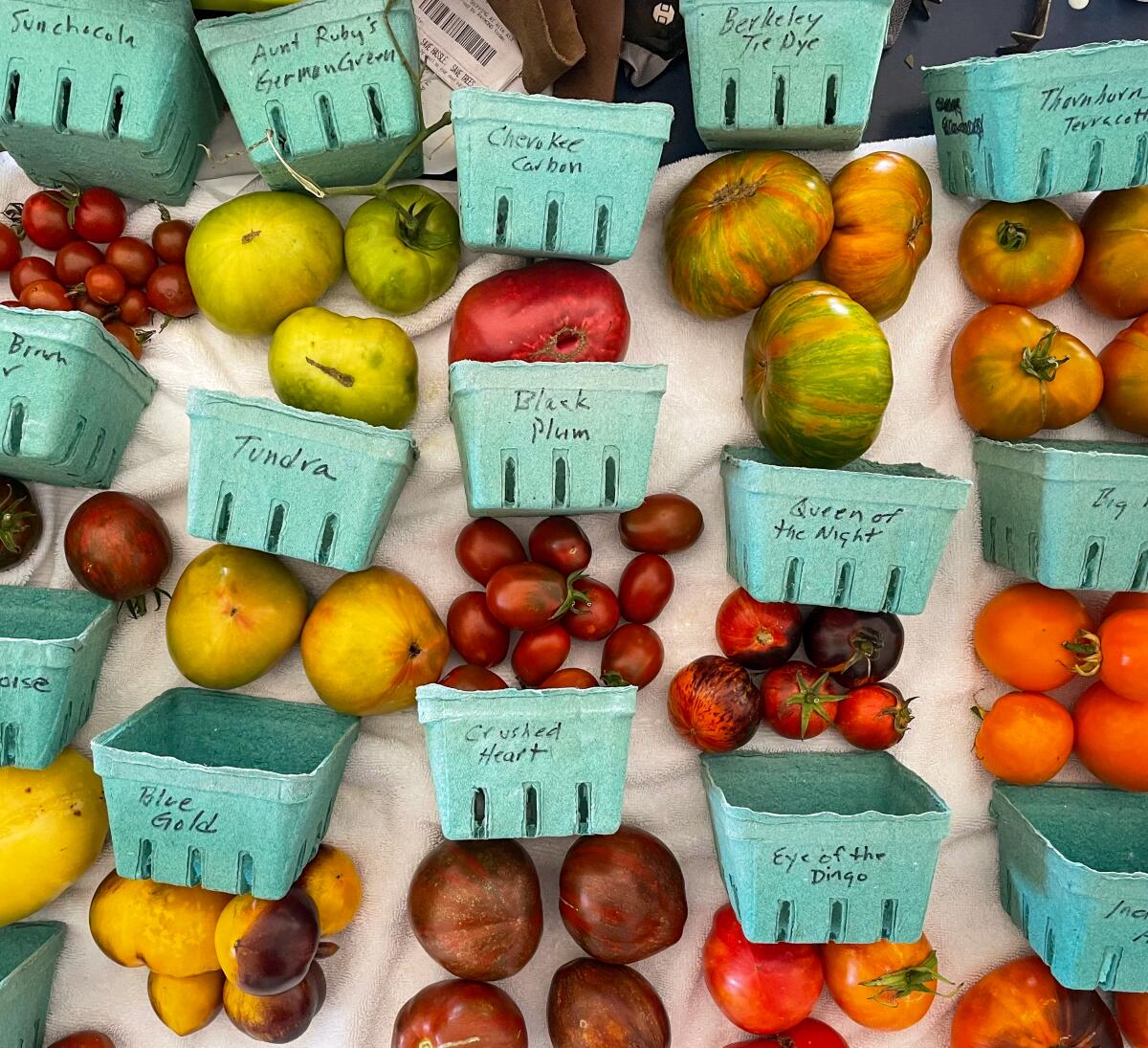
Eco-printing With Summer Plants: A natural dye workshop taught by artist and naturalist Erin Berkowitz, owner of Berbo Studio in Altadena, from 9 a.m. to noon at the Theodore Payne Foundation in Sun Valley. Participants will learn about natural dye plants and use natural dyes, flowers and leaves to create patterns on cotton socks, which they get to take home. All materials provided; suitable for ages 12 and older. Tickets are $85 ($75 for members). eventbrite.com
Workshop: Compost 101 at Apricot Lane Farms, 8 a.m. to noon or 1 to 5 p.m. at the farm in Moorpark. Learn how “The Biggest Little Farm” creates compost and uses it to nourish its soil. The event includes a one-hour tour of the farm. Tickets are $200. eventbrite.com
July 31
Recycling/Repurposing Household Throwaways Into New Garden Tools, a free class at 6 p.m. at the Katy Geissert Civic Center Library in Torrance, taught by master gardener Yvonne Savio, creator of the Gardening in L.A. website. library.torranceca.gov
Consider subscribing to the Los Angeles Times
Your support helps us deliver the news that matters most. Become a subscriber.
What we’re reading
Are squirrels taking over the world? That’s how it feels sometimes in my garden, where those saucy, fluffy-tailed rodents reign, seemingly without a care. My colleague Adam Tschorn took up arms against his furry foes when they emptied his bird feeder, and the result, a year later, is excellent reading.
Was Prince inspired by SoCal’s jacaranda blooms when he wrote “Purple Rain”? Because that’s all I could think of when my parents’ giant jacaranda bloomed every spring, sending cascades of purple flowers all over the yard. Some people hate the gooey mess those flowers leave behind, and others, like me, find it mesmerizing. Either way, reporter Lisa Boone has compiled a handy guide to places where you can revel in the blooms — or stay far away.
Speaking of Lisa Boone, she’s written another inspiring turf-removal story about a family who created a colorful “showstopping” low-water garden in Northeast L.A. where their toddler son delights in the bees.
“Aging yuppies in neon beachwear stand before a green wall with the catchphrase ‘You have changed ... so has cannabis.’” That’s the opening to an investigative article by The Times and cannabis industry newsletter WeedWeek, indicating that those “changes” aren’t what many expected from their legal, state-regulated weed: alarming levels of pesticides in cannabis products.
Sign up for The Wild
We’ll help you find the best places to hike, bike and run, as well as the perfect silent spots for meditation and yoga.
You may occasionally receive promotional content from the Los Angeles Times.
